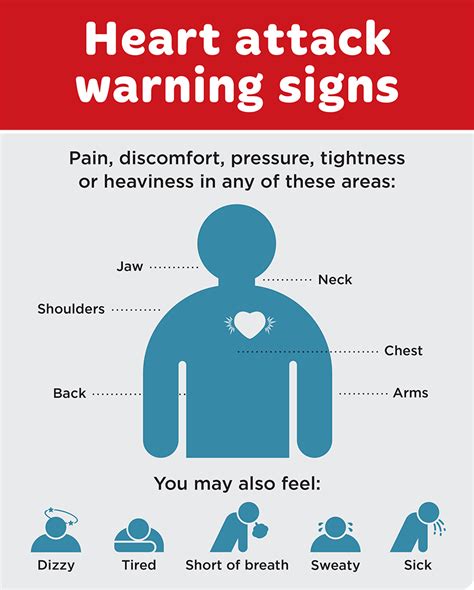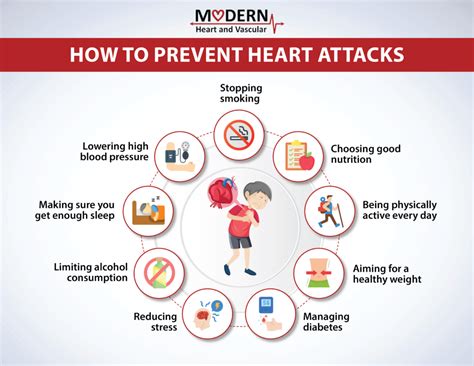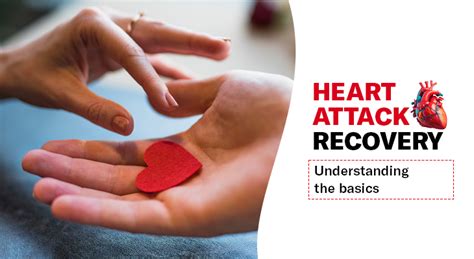Intro
Learn the 5 heart attack signs, including chest pain, shortness of breath, and fatigue, to recognize cardiac arrest symptoms and prevent cardiovascular disease with early detection and treatment.
Recognizing the signs of a heart attack is crucial for prompt medical attention and effective treatment. A heart attack, also known as myocardial infarction, occurs when the blood flow to the heart is blocked, causing damage to the heart muscle. The sooner a heart attack is diagnosed and treated, the better the chances of survival and minimizing damage to the heart. It is essential to be aware of the warning signs and symptoms of a heart attack to take immediate action.
Heart attacks can be sudden and intense, or they can start slowly with mild pain or discomfort. Some people may experience no symptoms at all, while others may have severe symptoms. The importance of recognizing heart attack signs cannot be overstated, as it can mean the difference between life and death. According to the American Heart Association, more than 350,000 out-of-hospital cardiac arrests occur annually in the United States, and the survival rate is less than 10% for people who experience cardiac arrest outside of a hospital.
The risk factors for heart attacks include high blood pressure, high cholesterol, smoking, obesity, diabetes, and family history of heart disease. While some of these risk factors cannot be changed, such as family history, others can be managed through lifestyle modifications, such as a healthy diet, regular exercise, and stress reduction. Being aware of the warning signs and taking preventive measures can significantly reduce the risk of a heart attack.
Common Signs of a Heart Attack

The most common signs of a heart attack include chest pain or discomfort, shortness of breath, pain or discomfort in the arms, back, neck, jaw, or stomach, and feeling weak, lightheaded, or faint. Chest pain or discomfort is the most common symptom of a heart attack, and it can feel like pressure, tightness, pain, or a squeezing or aching sensation in the chest or arms. The pain may radiate to the back, neck, jaw, or stomach, and it can be mild or severe. Shortness of breath is another common symptom, which can occur with or without chest pain.
Types of Heart Attack Symptoms
The symptoms of a heart attack can vary from person to person, and they can be different for men and women. Men are more likely to experience chest pain, while women are more likely to experience shortness of breath, nausea, and fatigue. Some people may experience no symptoms at all, which is known as a silent heart attack. A silent heart attack can be just as damaging as a heart attack with symptoms, and it can increase the risk of another heart attack.Warning Signs of a Heart Attack

The warning signs of a heart attack can occur hours, days, or even weeks before the actual event. These signs can include chest pain or discomfort, shortness of breath, pain or discomfort in the arms, back, neck, jaw, or stomach, and feeling weak, lightheaded, or faint. Other warning signs can include fatigue, nausea, and vomiting, as well as a cold sweat or pale skin. If you experience any of these symptoms, it is essential to seek medical attention immediately.
Risk Factors for Heart Attacks
The risk factors for heart attacks include high blood pressure, high cholesterol, smoking, obesity, diabetes, and family history of heart disease. High blood pressure and high cholesterol can increase the risk of a heart attack by damaging the blood vessels and reducing blood flow to the heart. Smoking can also increase the risk of a heart attack by damaging the blood vessels and reducing blood flow to the heart. Obesity and diabetes can increase the risk of a heart attack by increasing blood pressure and cholesterol levels.Preventing Heart Attacks

Preventing heart attacks requires a combination of lifestyle modifications and medical treatments. Lifestyle modifications can include a healthy diet, regular exercise, stress reduction, and quitting smoking. A healthy diet can help lower blood pressure and cholesterol levels, while regular exercise can help improve blood flow and reduce the risk of heart disease. Stress reduction techniques, such as meditation and yoga, can also help reduce the risk of heart disease.
Treatment Options for Heart Attacks
The treatment options for heart attacks depend on the severity of the attack and the individual's overall health. Medical treatments can include medications, such as aspirin, beta blockers, and ACE inhibitors, as well as procedures, such as angioplasty and stenting. In severe cases, surgery may be necessary to repair or replace damaged blood vessels.Recovering from a Heart Attack

Recovering from a heart attack requires a combination of medical treatments and lifestyle modifications. Medical treatments can include medications, such as beta blockers and ACE inhibitors, as well as procedures, such as cardiac rehabilitation. Lifestyle modifications can include a healthy diet, regular exercise, stress reduction, and quitting smoking. Cardiac rehabilitation can help improve blood flow and reduce the risk of another heart attack.
Cardiac Rehabilitation
Cardiac rehabilitation is a program that helps individuals recover from a heart attack and reduce the risk of another heart attack. The program can include exercise training, education, and counseling, as well as support groups and stress reduction techniques. Exercise training can help improve blood flow and reduce the risk of heart disease, while education and counseling can help individuals understand their condition and make lifestyle modifications.Final Thoughts on Heart Attacks

In conclusion, recognizing the signs of a heart attack is crucial for prompt medical attention and effective treatment. The common signs of a heart attack include chest pain or discomfort, shortness of breath, pain or discomfort in the arms, back, neck, jaw, or stomach, and feeling weak, lightheaded, or faint. Preventing heart attacks requires a combination of lifestyle modifications and medical treatments, while recovering from a heart attack requires a combination of medical treatments and lifestyle modifications.
We invite you to share your thoughts and experiences on heart attacks in the comments below. If you have any questions or concerns, please do not hesitate to reach out. We also encourage you to share this article with your friends and family to raise awareness about heart attacks and the importance of prompt medical attention.
What are the common signs of a heart attack?
+The common signs of a heart attack include chest pain or discomfort, shortness of breath, pain or discomfort in the arms, back, neck, jaw, or stomach, and feeling weak, lightheaded, or faint.
How can I prevent a heart attack?
+Preventing heart attacks requires a combination of lifestyle modifications and medical treatments. Lifestyle modifications can include a healthy diet, regular exercise, stress reduction, and quitting smoking.
What is cardiac rehabilitation?
+Cardiac rehabilitation is a program that helps individuals recover from a heart attack and reduce the risk of another heart attack. The program can include exercise training, education, and counseling, as well as support groups and stress reduction techniques.
